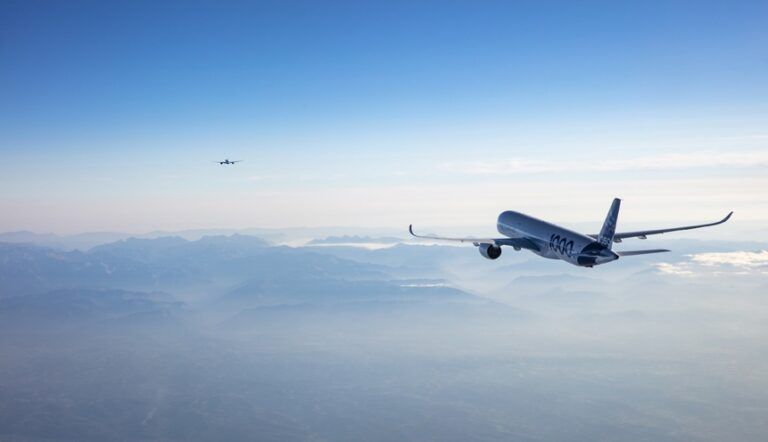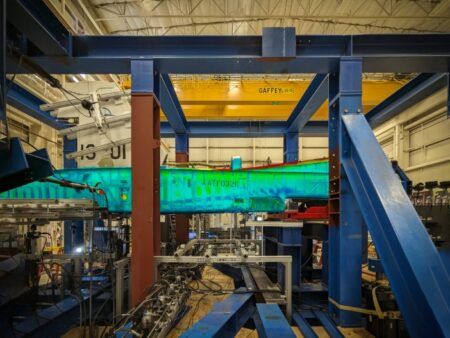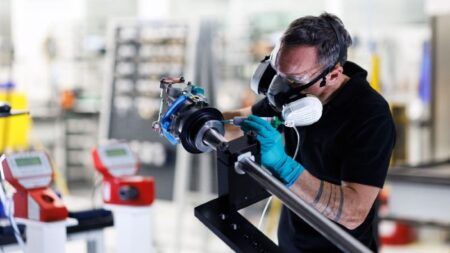Airbus is to run flight tests of the Wake Energy Retrieval concept during the second half of next year with airlines, a technique where aircraft ride the buoyant wakes of others to reduce fuel consumption and emissions.
Wake Energy Retrieval (WER) was developed and tested by Airbus’ two year fello’fly R&D program which started in 2019. WER sees a pair of airliners flying in formation, allowing the trailing aircraft to benefit from the lift generated by the preceding aircraft’s vortices, reducing the thrust required from its engines.
WER was inspired by observing flocks of geese, which use a similar technique when they migrate in formation, flying over long distances, while benefiting from each other’s wake energy.
Analyses of the fello’fly flight tests suggested that airlines could save between five and 10% of fuel per trip.
The successor program to fello’fly is the three year, EU-funded €10 million (US$11 million) GEESE (Gain Environmental Efficiency by Saving Energy) project, which aims to map out how to implement WER for transatlantic and trans-continental flights.
Wake vortex tracking
The project is defining the necessary operational tasks for pilots adopting the technology to automatically manage various WER positions – including flight management systems and new WER cockpit functions that capture and track the wake vortex.

The campaign is also exploring a pairing assistance system for dispatchers at airline operations control centres. Notably, airline partners will work together to update their flight plans to find suitable aircraft to pair, taking into account routing to rendezvous point and other considerations.
To this end, the project will run a series of simulations to validate the pairing procedures, involving Air France, French Bee, Delta and Virgin Atlantic airlines. It will also further investigate wake science, to advance the underlying concepts and consider the impact of formations. This includes defining the wake generated by the second aircraft in a pair, safe positioning behind the pair, and how to ensure the safety of surrounding traffic.
Three operational ‘work packages’ are being developed within GEESE. Enable Europe to North Atlantic WER Operations will develop and refine the initial concept-of-operation (CONOPS), its safety assessment, analyse impacts on legacy systems, and develop simulations and trials to assess assumptions.
Scaling-up the WER concept to continental Europe, will provide operational solutions for the extension of WER operations within European domestic airspace. The third facet to GEESE, the Wake Science work package, – will investigate non-CO2 potential benefits of formations.
Next steps for GEESE
“Today, one year into the project we are mainly working on the definition of the operational processes which will be needed for preparing the WER operations,” says Laura Montironi, vehicles systems architect, in Airbus Engineering.
“These processes will govern how the two aircraft will adapt their trajectories. We will develop these processes together with the airlines and the controllers, so they can perform the flight plan changes and any adaptations that will enable the aircraft to meet.”
“We have made good progress to agree with stakeholders on the processes, paving the way for planning and detailing all the validation activities which we will perform next year.”
“This year we also launched the safety assessments,” she adds. “The flights are planned to start around the second half of 2025.”
During the flight trials to be operated by Air France, French Bee, Delta and Virgin, the respective paired aircraft will be positioned at different altitudes – in accordance with today’s normal ATM vertical separation minima requirements. This constraint is not an issue for the GEESE trials, since their aim is not to re-demonstrate the WER uplift flight-physics, which was already demonstrated as part of fello’fly, but rather to validate the processes needed for the aircraft to converge and meet as a pair, from a navigational perspective.
Regarding the aircraft types to perform the tests, Montironi says, “We are still converging on defining these, and that depends on the airlines’ respective flight planning.
“For the transatlantic flights, it depends on which aircraft they will use on those sectors at the time of the trials. For Airbus, A350 will most likely be our platform of choice, especially given that it’s a long-range aircraft whose avionics and navigation capabilities are of the very latest standard.”

Flight plan flexibility
Although not a prerequisite , it would be advantageous if aircraft would enable the pilot to upload the flight plan directly into the aircraft’s flight management system (FMS). This capability, which is already available in the A350, avoids the pilot having to make flight plan modifications by entering all information manually using the aircraft’s MCDU keypad.
Once uploaded into the FMS the new flight plan will be selectable as a secondary flight plan option, while the original flight plan would remain in the FMS as the primary flight plan.
For airline operations it is envisaged that the new flight plan would only be released and sent by the airlines operations centre (AOC) to the pilot following a consultation and coordination between the AOC and the ATC controllers – who would be impacted by any flight plan change.
This would be done as part of a CDM workflow, during which the respective ATM controllers would confirm if they can accept changes, for example taking into account sector loading or airspace constraints. Only once the new flight plan is approved would the pilot be authorized to activate the secondary flight plan in the FMS.
Moreover, the fuel load would remain exactly as per the original flight plan.
“The fuel loaded would not be impacted, as it will be based on the ‘no-WER’ scenario,” says Montironi. “In fact, what we propose is that the respective airlines will not know if they will effectively constitute a pair. They will just declare their intention that their flight could be part of WER.”
Aircraft agnostic
While the WER trials will be essentially aircraft agnostic, Montironi advises on some general requirements: “For example, a function able to automatically position the follower aircraft automatically behind the leader aircraft and track its vortex.
“However, what we would not do is dictate how this capability or aircraft functionality should be implemented in a specific aircraft design and how the aircraft technology would accomplish it.”
Montironi adds, “For Airbus, this is done separately by our engineering colleagues in fello’fly. For other aircraft OEMs it would be up to them how they would want to implement the technical features.”
“Nevertheless, in GEESE, we are discussing whether we can extend the scope of the trials to include the A330 and some Boeing aircraft. We don’t have huge operational constraints on the aircraft itself – WER operation is mainly a flight plan change, so we are under discussion with airlines to evaluate the concept with a large set of aircraft types.”
Like fello’fly before it, GEESE is part of the EU’s SESAR (Single European Sky ATM Research) program. The program involves stakeholders including Eurocontrol, DSNA, Air France, ON, Indra, ENAC, DLR, AirNav, Bulatsa, CIRA, UAB, Frequentis, Boeing, French Bee, NATS, Virgin Atlantic and Delta Air Lines.
This article was first published by Airbus and can also be read here.





